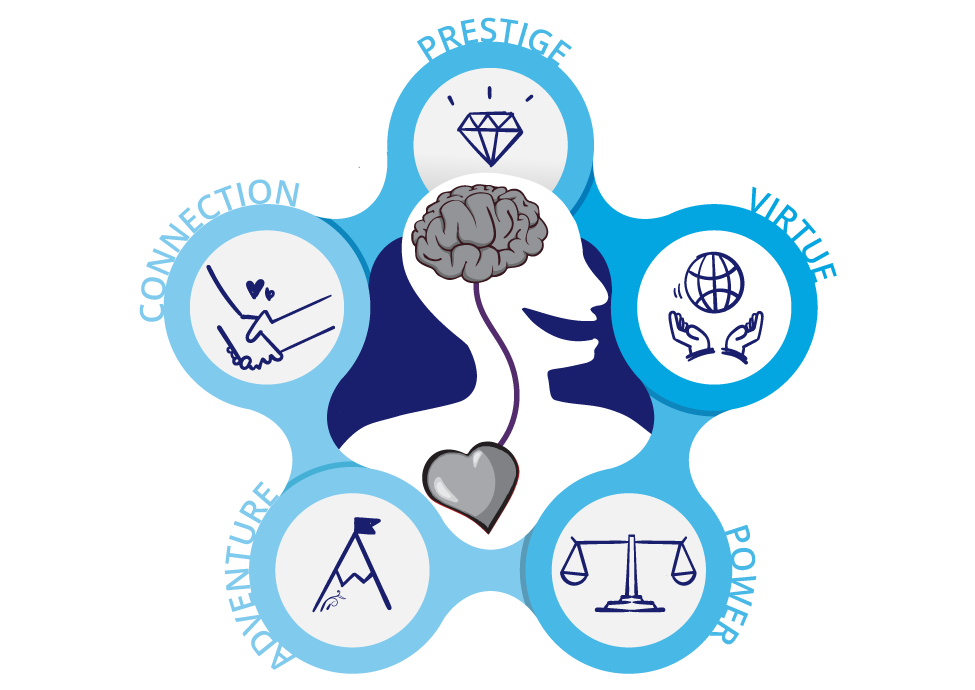Brand Strategy: The Effective Way to Successfully Grow Your Brand

Think of your brand as an evolving story. A story that can potentially touch your customers’ minds and hearts. Your brand strategy is the way you plan to tell that story effectively.
Any tale requires a good plan. The plan, or brand strategy, for your story involves many components—products, services, design, marketing, advertising and, above all else, meaning and emotion. Resultantly, a successful brand does one core thing really well. It connects emotionally with the target audience in a focused and specific way so that people recognize themselves as characters in the story.
Experienced marketers build brand stories around common emotional needs—friendship, love, freedom, fun and so on. The distinct manner in which you convey your brand’s one-of-a-kind story to your defined customer base is your brand strategy. An effective plan will help you stand out in the marketplace and stay ahead of the competition. The more thought out and well-defined your creative strategy is, the more likely you are to easily grow your brand over the long-term.
Brand positioning basics
Before you implement any marketing campaigns, it is essential that you clearly define your brand positioning. Indeed, what your business uniquely stands for.
- Who exactly are your ideal customers?
- What is special about your product or service?
- Why would people choose your product or service over that of a competitor?
Capturing the essence of the experience your brand delivers is essential. A concise brand positioning statement will inform all storytelling. Moreover, it will impact how your audience experiences your story. One tricky area many business owners get caught up in is the “safeness” of trying to please everyone. It’s not safe. Instead, trying to attract everyone can prevent your brand from being seen as the best in any category. A company that tries to appeal to everyone doesn’t connect deeply with anyone. A generic story is a forgettable one. Establish brand loyalty by genuinely understanding the needs and motivations of your target audience. They are, after all, co-creators and co-owners of your brand.

Brand audit basics
A brand audit is a valuable tool to assess your brand’s strengths and weaknesses. A clear picture of where your business stands in the marketplace can enable a more clearly defined and delivered competitive advantage.
A brand audit usually consists of analyzing:
- Internal branding, including purpose, beliefs and company culture.
- External branding, including brand assets, print and digital literature, advertising, website content and ranking, email marketing and social media.
- Customer experience, including sales, service and support.
To be sure, a company’s overall current health will point to the most appropriate next-phase brand strategy.
Defining your competitive advantage
Your ability to stay ahead of and apart from the competition in the marketplace is your competitive advantage. Evaluating both your own and your contenders’ strengths and weaknesses will help in at least two ways.
First, it can help you deliver a truly unique product or service. Is there anything that you do well that they don’t and vice versa? Is there anything you could be good at, but neither you nor your competitors are doing yet? If there is, it may be time to step up. By developing or improving your brand’s attributes, you could be positioned to fill this gap in the market.
Second, getting clear on your position relative to the competition helps inform marketing strategy. As marketers, we look at your business from the perspective of buyers. What options do buyers have? While evaluating your service, what other brands will they be reviewing? Which brands are the easiest to find online? Defining your competitive advantage upfront ensures that your marketing helps the right people find and connect with your brand.
Be your own best competitor
Creating valuable consumer experiences is what it’s all about. If done right, the rewards are both immediate and long-lasting.
In the marketplace, where all involved strive to outperform each other and win, the need to directly compete might seem like an absolute certainty. The unfortunate reality of such an environment is that someone must always lose. One way to ensure this is not you is to map out a precise brand strategy. Focus more, if not entirely, on your own story, your product and your ideal customer. Create and deliver value consistently. This immediately starts building a happy and loyal customer base.
Otherwise, you might suffer from one of the side effects of a fiercely competitive market, called “clustering.” Companies gradually begin to conform and start doing the same thing. As a consequence, the offering becomes commodified, and generic ventures turn unproductive. On the other hand, when a market “de-clusters,” it becomes a more balanced commercial environment. In this scenario, companies have space to explore strategic advantages, expand and eventually thrive.
Know who you are. Don’t be afraid to think and do things differently.
The long-lasting benefits are worth it. With that in mind, capturing and growing a large customer and loyal fan base takes time. Creating a stand-out brand story that is consistently delivered across all marketing channels is a daunting feat. Conceptual and technical design elements must sync. It takes many resources and an ongoing budget. Without a dedicated professional managing all aspects, haphazard marketing efforts may not propel your brand forward as expected. This is where partnering with a reliable marketing agency really matters. An experienced marketer will be able to prioritize marketing efforts, optimizing the use of marketing dollars. In other words, they can help avoid budget waste and lost marketing momentum.

Stand out with your brand strategy
Many different factors play a role in why people choose a certain product or service over another. Whether they desire to feel virtuous, adventurous or connected, your story must attract their attention.
There are many products on the market. Why should consumers choose your product brand?
Below are a few examples of how big businesses strategize to develop a competitive advantage, stand out from the crowd and successfully expand.
Brand differentiation strategy
Companies that gain leverage by using the differentiation strategy focus on how they diverge from their competitors. The point of separation is not necessarily only their product or service quality or quantity, but also how they are introduced and delivered to their customers.
Do these companies invest in special production systems? Is their process faster or more flexible? Do they communicate better? Are they eco-friendly and more mindful than their competitors?
One great example of how to stand out in a crowded industry is the British cosmetic brand Lush. Known for sticking to ethical standards, it provides benefit trusts to all its employees. Lush products are handmade and largely devoid of chemicals. The company is 100% cruelty-free; it refuses to deal with businesses that test on animals. All profit from charity efforts goes to environmental issues as well as human and animal welfare.
Product quality
Some enterprises create their competitive advantage in the marketplace by highlighting the quality of their product or service.
A good example of this is any luxury brand, such as Prada, Gucci or Chanel. These labels focus on artistic skills and the production of premium goods as the best way to make a profit.
Cost leadership
Companies that attract customers by low or lowering prices lead with cost.
While competing on price may be profitable for big retailers (Canadian Tire, The Brick, Sport Check, etc.), small business ventures risk losing profit. As they have less cash, they can be vulnerable to the slightest fluctuation in cost. For them, producing large volumes of product, which is key for this brand strategy to work, is risky business.
Operational effectiveness
Some firms lead with quicker and better delivery of products and services.
Amazon is an expert at time efficiency. With its use of robots and organized warehouses, goods can be found in different places at the same time. This speeds up pickups, and shipment is ensured in the shortest time possible.
Similarly, a simple innovation, overnight delivery, made FedEx become the efficient company that it is now.
Technology
Nowadays, it would be a grave mistake for any business to ignore modern technological advancements. Although this wasn’t common in the early 2000s, some companies were visionary enough to recognize the beneficial aspects of developing technologies.
PointClickCare had to wait for everybody else to catch up after the culture started changing. An early adopter of the cloud solution, the company revolutionized the senior care industry. By creating an online network, caregivers could easily access their patient’s electronic health records.
Apple is another business making the most of technology, particularly with its easy-to-use products. Yet another one is Amazon Echo that marries voice recognition features with product delivery.
Innovation
Exploring new methods and products, in line with the present and inspired by the future, means to lead with innovation.
Usually, companies will use novelties to get better solutions faster.
One excellent example of this is Axonify, an employee knowledge platform that is redefining e-learning related fields. In support of a different approach to gaining knowledge—microlearning—the company provides targeted lessons in easily ingested and retained segments. It teaches skills and provides tools for employees in quick, fun and customized ways.
Adaptability
Businesses that change their products and services to adapt to the market develop an adaptability advantage.
Emerging cultural trends and society’s wants and needs will often force companies to do something different. Accordingly, a venture is rarely profitable if it doesn’t provide consumers with products relevant to the present.
For this reason, companies should always have their receivers tuned to the next big signal. The faster they pick up on it, the more likely they are to roll with the punches of disruptive technologies. Tackling them head-on, they expand rather than crumble.
Kodak is one of the classic examples of strategic failure. The company chose to ignore a crucial digital innovation and failed to build on what it already did well—film photography.
On the other hand, a near-perfect example of gaining a competitive advantage by adapting is Netflix. As DVD sales kept plummeting, Netflix looked for ways to stay afloat. Eventually, the company capitalized on the novel idea of internet streaming and changed how people perceive film and TV entertainment forever.
Riding the wave of the booming space industry, NorthStar is another success story. With its constellation of optical sensor satellites, the company has begun to monitor space from space. Its mission: to revolutionize the safety of spaceflight.
Information
In the age of the internet, no currency is more valuable than information. Having the right knowledge is necessary if all relevant aspects of a business venture are to sync together and make it successful.
No company has used this fact better than Google. It has acquired a huge amount of potentially sellable data, thus gaining an incredible competitive advantage in the marketplace.
A brand strategy positioned for success
Ultimately, starting and building a successful business is a strategic, intellectual, creative and intuitive venture.
Of course, it’s also stressful. Will you succeed or fail? There are many sets of knowledge required to make it. Do you actually know enough to get off the ground? Remember that all successful people start at the beginning, from scratch. This is precisely why being at the top feels so good. But they build a team of people who know more than they do in various areas. A strategic marketing professional that partners with you removes a lot of this stress.
Understand what your business is about and make everything about it line up.
Know who your competitors are, how you compare to them and where you stand in the marketplace. A brand strategy based on an objective perspective can help you stand out in the sea of commercial sameness.
While your business is yours, your brand is for your customers. When they consume what you’ve promised and hopefully delivered, they become emotionally and financially invested in the story you are telling. Think about them first and strive to make them happy.
Be consistent. Consistency breeds brand loyalty.
Being memorable wins the game.
Compete by being different and continually looking for ways to improve the lives of your customers.
Partner with a marketing professional who has your back and can take the marketing reins. Growing a profitable business venture over the long-term is no easy task for brand owners who are just starting. Rebranding an established brand is also a huge task. A clearly positioned brand and the right marketing partner make all the difference.
Tanja Groos, Founder and CEO, Mindspin® Studio Inc.
Tanja Groos is CEO Mindspin with more than 20 years of experience in branding and digital marketing. Her work has been published and awarded. Her leadership has tripled sales within a year, surpassed top industry competitors online, and enhanced brand credibility for her clients.
Follow Tanja on LinkedIn












